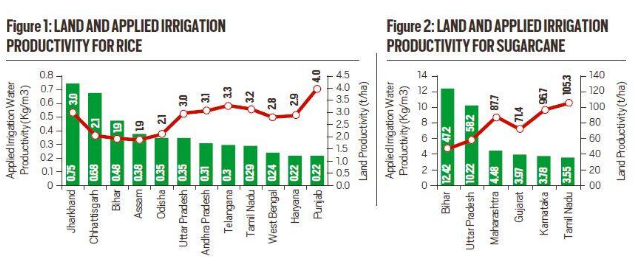ForumIAS announcing GS Foundation Program for UPSC CSE 2025-26 from 19 April. Click Here for more information.
Synopsis:
The declining availability and accessibility of water necessitates strengthening the water management measures. In this regard, the focus should be drawn on Sustainable Agriculture.
Background
- On March 22 (World Water Day), Prime Minister launched the ‘Catch the rain Campaign’ under Jal Shakti Abhiyan.
- The campaign focuses on robust rainwater conservation including the use of MGNREGA funds to conserve water.
- These types of campaigns are desired as water demand is going to rise in future – 843 billion cubic metres (BCM) by 2025 and 1180 BCM by 2050.
Current Situation of Water:
- National Estimates:
- NITI Aayog’s Composite Water Management Index (2019) shows 75% of Indian households don’t have access to drinking water on their premises.
- The Central Water Commission’s reassessment of water availability using space inputs (2019) shows India utilises only 18% of its annual precipitation. This means 699 billion cubic metres (BCM) is utilised, out of the total 3880 BCM received.
- International Estimates:
- UN’s report on Sustainable Development Goal-6 (SDG-6) on “Clean water and sanitation for all by 2030” states that India achieved only 56.6 per cent of the target by 2019.
- The Water management quality Index has placed India at the 120th position amongst 122 countries.
- India identifies as a water-stressed country. As the per capita water availability declined from 5,178 cubic metre (m3)/year in 1951 to 1,544 m3 in 2011. It is expected that it will reach 1,140 cubic metre by 2050.
Why do we need to focus on the agriculture sector?
- Firstly, High Usage of water: The Agriculture Sector uses 78% of freshwater resources and the rest is used by industry and households.
- Secondly, Skewed Irrigation Distribution: Only about half of India’s gross cropped area (198 million hectares) is irrigated. Groundwater contributes about 64 per cent, canals 23 per cent, tanks 2 per cent and other sources 11 per cent to irrigation.
- Thirdly, Inefficient usage of water: Groundwater is the primary source of irrigation. Various subsidies and incentives are given to support it. However, it has led to over-exploitation of water especially in the north-west region.
- This helped the region to leverage maximum benefits of the green revolution at subsidized water and power tariffs.
- But today the region is amongst the three highest water risk hotspots of the world along with northeastern China and the southwestern USA (California).
- Fourthly, Two Crops use maximum water: As per a NABARD-ICRIER study on Water Productivity Mapping; rice and sugarcane alone consume almost 60 % of India’s irrigation water.

- Punjab performs well inland productivity of rice but takes the last spot in terms of irrigation water productivity. This shows inefficient usage.
- Similarly, irrigation water productivity of sugarcane in Karnataka and Maharashtra is only 1/3rd of Bihar and U.P.
- Land Productivity means output produced per unit of land.
- Irrigation water productivity means output produced per unit of irrigation water used.
Therefore, there is a need to realign the cropping patterns based on per unit of applied irrigation water productivity.
Way Forward
- Firstly, technologies like Drip irrigation, Direct Seeded Rice (DSR), drip with fertigation etc. can be adopted.
- Jain Irrigation has demonstrated the potential of water conservation by growing 1 kg paddy with 842 litres using drip irrigation. This is way less than the traditional flood irrigation method that uses 3065 litres.
- Similarly, drip with fertigation method for sugarcane has given a benefit-cost ratio of 2.64 in Karnataka.
- Netafim, an Israel based company, has shown the potential of a family drip irrigation system at Ramthal, Karnataka.
- Secondly, pricing policies for agricultural inputs like water and electricity should be sustainable.
- The “Paani Bachao Paise Kamao” initiative of the Punjab government along with the World Bank and J-PAL can be a good initiative in this regard.
- It encourages rational use of water amongst farmers by providing them monetary incentives for saving water in comparison to their traditional usage.
- Further, from highly subsidised policies, a paradigm change towards direct income support and greater agricultural investment is desired.
The focus should be on conserving, using and managing the water in such a way that the objective of per drop more crop is duly achieved.
Source: indianexpress




